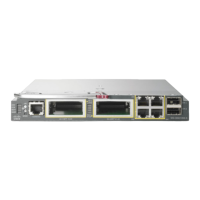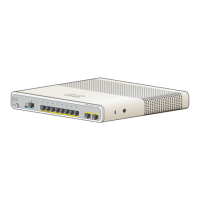With VTP version 1 and version 2, if you try to create an extended-range VLAN when the device is not in
VTP transparent mode, the VLAN is rejected, and you receive an error message.
If you enter an invalid VLAN ID, you receive an error message and do not enter VLAN configuration mode.
Entering the vlan command with a VLAN ID enables VLAN configuration mode. When you enter the VLAN
ID of an existing VLAN, you do not create a new VLAN, but you can modify VLAN parameters for that
VLAN. The specified VLANs are added or modified when you exit the VLAN configuration mode. Only the
shutdown command (for VLANs 1 to 1005) takes effect immediately.
Although all commands are visible, the only VLAN configuration commands that are supported on
extended-range VLANs are mtu mtu-size, private-vlan, and remote-span. For extended-range VLANs,
all other characteristics must remain at the default state.
Note
These configuration commands are available in VLAN configuration mode. The no form of each command
returns the characteristic to its default state:
• are are-number—Defines the maximum number of all-routes explorer (ARE) hops for this VLAN. This
keyword applies only to TrCRF VLANs. The range is 0 to 13. The default is 7. If no value is entered,
0 is assumed to be the maximum.
• backupcrf—Specifies the backup CRF mode. This keyword applies only to TrCRF VLANs.
◦ enable—Backup CRF mode for this VLAN.
◦ disable—Backup CRF mode for this VLAN (the default).
• bridge {bridge-number | type}—Specifies the logical distributed source-routing bridge, the bridge that
interconnects all logical rings that have this VLAN as a parent VLAN in FDDI-NET, Token Ring-NET,
and TrBRF VLANs. The range is 0 to 15. The default bridge number is 0 (no source-routing bridge) for
FDDI-NET, TrBRF, and Token Ring-NET VLANs. The type keyword applies only to TrCRF VLANs
and is one of these:
◦ srb—Ssource-route bridging
◦ srt—Source-route transparent) bridging VLAN
• exit—Applies changes, increments the VLAN database revision number (VLANs 1 to 1005 only), and
exits VLAN configuration mode.
• media—Defines the VLAN media type and is one of these:
The device supports only Ethernet ports. You configure only FDDI and Token Ring
media-specific characteristics for VLAN Trunking Protocol (VTP) global advertisements
to other devices. These VLANs are locally suspended.
Note
◦ ethernet—Ethernet media type (the default).
◦ fd-net—FDDI network entity title (NET) media type.
◦ fddi—FDDI media type.
Command Reference, Cisco IOS XE Everest 16.5.1a (Catalyst 3650 Switches)
1054
vlan

